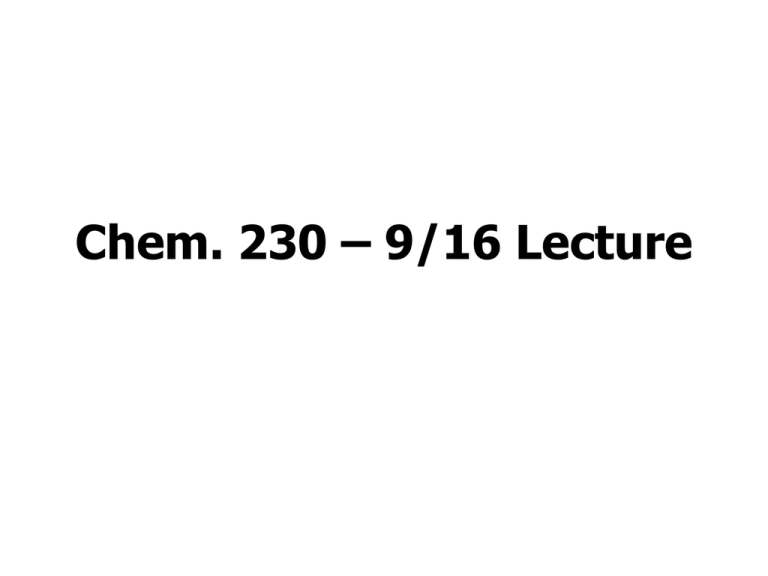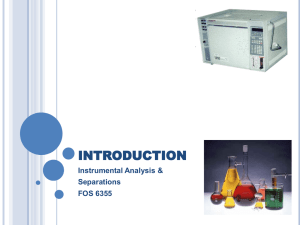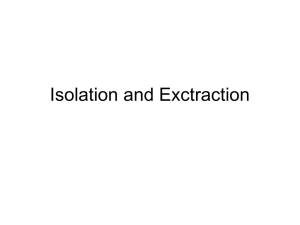Sept. 16 Lecture Notes
advertisement

Chem. 230 – 9/16 Lecture Announcements I • First Homework Set (long problems) due today (solutions will be posted soon) • Website now has Fall 2012 quizzes (as well as solutions) posted • Specialized Topics sign up list available (some blank slots if you want your own topic if approved) • Next Tuesday: Exam 1 for first 40 minutes Announcements II • Today’s Lecture: – guest lecture (Dr. Justin Miller-Schulze on SPE) – other advanced extraction techniques (primarily SPME) – comparison of extraction with chromatography (to transition to chromatography theory) – introduction to chromatography theory • Last two topics (comparison of extraction with chromatography and chromatographic theory) not on Exam 1 Advanced Extraction Techniques Solid Phase Micro Extraction (SPME) • First described in Arthur, C.; Pawlisyzn, J.; Solid phase microextraction with thermal desorption using fused silica optical fibers, Analytical Chemistry (1990) 62, 2145-2148. • Can be used for subsequent analysis by GC or HPLC, but most common with GC • Typically, non-exhaustive type sampling (meaning only a portion of analyte in sample is trapped). Quantitation is based on keeping exposure to samples the same (easier with autosampler). • While quantitation is often difficult, sensitivity is enhanced relative to SPE because whole trapped sample is injected. • The other advantage of SPME is the reduction in required labor Advanced Extraction Techniques SPME Procedure • The needle pierces the septum to a sample (sample can be gas, liquid, or headspace) • The sheath is removed allowing trapping of analytes on fiber • Coating is similar to GC stationary phase but outside of solid core • Stirring helps the transfer • The sheath goes back and the needle is withdrawn • The needle pierces the septum to a GC, the sheath is withdrawn and the analyte is desorbed by the heated GC injector Fiber Cross Section solid core coating Fiber GC Inlet Advanced Extraction Techniques SPME - Injection • In HPLC – Requires specialized injection valve – Analytes desorbed from SPME fiber into solvent flowing around fiber (should be strong solvent) – Use in HPLC is less developed • Transfer off of fiber – This may take time, particularly for less volatile compounds in GC and for compounds with polarity more like stationary phase than solvent in HPLC – Good peak shape usually requires “on column trapping” – In GC, this is done by splitless injections with the column initially at low temperatures Advanced Extraction Techniques Solid Phase Micro Extraction (SPME) • Fiber “Variables” – One can select fibers of different polarities and film thicknesses – A polar fiber will selectively trap polar molecules – Thinner films used for faster sorption/desorption – A practical consideration is thermal stability Advanced Extraction Techniques Solid Phase Micro Extraction (SPME) • Sample Types (GC analysis) – Liquid Samples • best for relatively clean samples at lower concentrations • best if analyte has polarity like coating and different than solvent (e.g. non-polar analyte and coating in water) – Headspace Sampling • fiber is in space above liquid sample • good for “dirty” samples (e.g. flower components) • preferentially absorbs moderately volatile species – Gas Samples – In Fiber Derivatization (typically applied to polar organic compounds which often decompose on GC columns) Advanced Extraction Techniques SPME vs. Liquid – Liquid Extraction for Water Phase in Synthetic Diesel • Synthetic diesel made from CO + H2 • Products are CxHy + H2O • Some impurities (e.g. alcohols) end up in water phase 4.465 DCM extract 2.948 14 4.162 2.768 16 1.810 1.925 1.612 FID1 B, (Y VONNE\09181302.D) pA solvent peak 12 3.974 2.713 4 7.843 1.729 6 2.390 8 6.271 1.523 10 2 0 1 2 3 4 5 6 7 8 min 3.168 FID1 B, (TODD\11041305.D) pA 6.269 100 4.494 2.824 120 80 headspace SPME injection 2.863 60 benzene (1st) + butanol (2nd) 7.831 10.393 9.185 8.245 7.287 5.679 4.913 47 A4.003 re a: 19 4.442.76 20 2.494 A1.738 re a: 12.043 3. 96 48 40 0 0 2 4 6 8 10 min Advanced Extraction Techniques Solid Phase Micro Extraction (SPME) • Areas of Applications (reviews on these areas) – Environmental Analysis (VOCs in air, pesticides in water, soil/sediment analysis, toxic metals) – Biological Samples – Food Analysis – Natural Products Advanced Extraction Techniques SPME – Advantages/Disadvantages • Advantages: – Listed as “Solvent-less” technique (at least great reduction in solvent injected into GC) – Less interference from solvent peak – Reduced injection of non-volatiles – Less sample handling (+ ability to automate) – Can chose fibers for good selectivity • Disadvantages: – More difficult for quantitative results – Limited lifetime of fibers – Memory effects (slow desorption from fibers) Advanced Extraction Techniques Other Methods • Emphasis toward microscale methods • Liquid-Liquid Microextraction (drop scale liquid liquid extraction) • Use of semi-permeable membranes (discussed in text) • Stir-Bar Sorptive Extraction 1. Stir bar traps analytes 2. Stir bar transferred to GC inlet Advanced Extraction Techniques Some Questions 1. A test for decomposition of a milk sample is made by measuring small aldehydes (e.g. butyraldehyde) by SPME through direct immersion in milk. A non-polar fiber is used and analysis is performed by GC with a non-polar stationary phase. Which of the following are advantages of using the SPME method: 1. 2. 3. 4. 2. 3. 4. removal of interferents (other parts to milk) 2 dimensions of separation (on SPME fiber and on GC column) increase of concentrations by trapping on fiber avoiding need for more labor intensive methods (e.g. liquid – liquid extraction) If a fiber sits in a solution long enough, the peak area will reach a constant (be independent of time). Why is this? Is this exhaustive extraction? In SPME for HPLC, analytes are desorbed from the fiber into solvent that is injected into the HPLC column. Should the solvent be “stronger” or “weaker” than the sample solvent? In comparing direct headspace injections with SPME headspace injections, later eluting peaks (by GC) are larger in SPME. Explain why. Chromatographic Theory Simple Separations vs. Chromatography • Simple separations generally involve one to several process steps that lead to two to several fractions. • Simple separations are limited to coarse fractionation of samples. • Chromatographic separations are generally capable of isolating more than 5 compounds. • Once the number of simple separation steps goes over a few (maybe 5 maximum), it becomes a labor inefficient way of performing a separation. Chromatographic Theory Simple Separations vs. Chromatography • Example of separation of two compounds by LLE. – Compound X has Kp = 0.25 and Compound Y has Kp = 4. Extraction of X and Y using n washes with extractant phase (equal volumes and saving all extractant phase) – To get efficient transfer of X means transferring a fair amount of Y also (poor selectivity) Number Extractions (n) 1 Fraction X transferred 0.800 Fraction Y transferred 0.200 2 3 0.960 0.992 0.360 0.512 Chromatographic Theory Simple Separations vs. Chromatography • Continuation of example – Better selectivity at same efficiency can be made by adjusting extract volume and increasing number of extractions – In past example, using Vraf/Vext = 2.5/1 with 5 extractions results in 99% efficient transfer of X, while only transferring 38% Y – Table shows dependence of %Y transferred on Kp values (assuming Kp(Y) = 1/Kp(X)) and 99% transfer of Y with 3 extractions (volumes adjusted to get ~99% transfer of X) Kp(X) 100 % Y also transferred 0.1 20 5 2 2.7 33 85 Chromatographic Theory Simple Separations vs. Chromatography • Chromatography example – Even column of poor efficiency can handle much more similar compounds – Example: KY/KX = 1.25 (= a value) – If we assume kX = 4, and resolution = 1.5 (minimum for “baseline”), a plate number of ~1000 would be needed (not very high) Chromatographic Theory Simple Separations vs. Chromatography • Conclusions to example: – Unless order of magnitude differences in Kp values, simple separations have limited use (e.g. reduction of interfering substance). – Simple separations are better for coarse separations – Chromatographic separations can handle similar K values much better. Chromatographic Theory Chromatography vs. Other Advanced Separation Techniques • Chromatography is based on analyte partitioning between two phases • Other methods use different mechanism for separation of analytes (e.g. electrolytic mobility in capillary zone electrophoresis) • Some areas of overlap (e.g. Capillary electrochromatography and size exclusion chromatography) Chromatographic Theory Phase Definitions • Mobile Phase (M subscript in later parameters) – Fluid phase (gas, liquid or supercritical fluid) that moves through stationary phase – Mobile phase defines the major classes of chromatography (GC, LC and SFC) • Stationary Phase (S subscript) – A non-moving phase (except in MEKC) to which compounds partition via absorption or adsorption – Phase can be liquid (not very stable), liquid-like (most common), or solid (common for some applications) – In past was second part of class name (for example GLC for gas-liquid chromatography) Chromatographic Theory More on Stationary Phases • Stationary phases come in several arrangements: in columns or on plates (used in thin layer chromatography) • In columns, open tubular (coated walls), packed columns and monoliths are possible means of attaching stationary phase • Packed columns contain packing material with the stationary phase either being the surface or being a coating on the surface • Porous packing material is common • Most common stationary phase is a liquid-like material chemically bonded to packing material or to wall (in open tubular chromatography). Chromatographic Theory More on Stationary Phases Open Tubular (end on, cross section view) Packed column (side view) (e.g. Silica in normal phase HPLC) Column Wall Mobile phase Stationary phase (wall coating) Expanded View Packing Material Stationary phase is outer surface (although influenced by adsorbed solvents) Bonded phase (liquid-like) Stationary Phase Chemically bonded to packing material Packing Material Note: true representation should include micropores in sphere Chromatographic Theory Definition Section • Chromatograph = instrument • Chromatogram = detection vs. time (vol.) plot Chromatograph Components Sample In Chromatographic Column Flow/Pressure Control Mobile Phase Reservoir Injector Signal to data recorder Detector Waste or fraction collection Chromatogram








